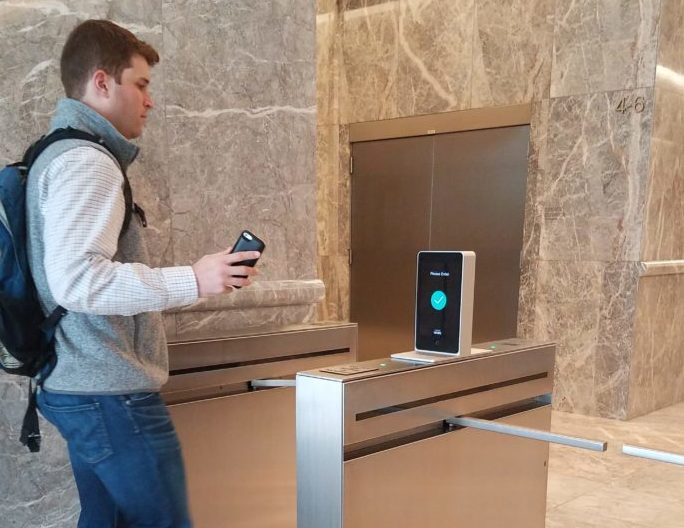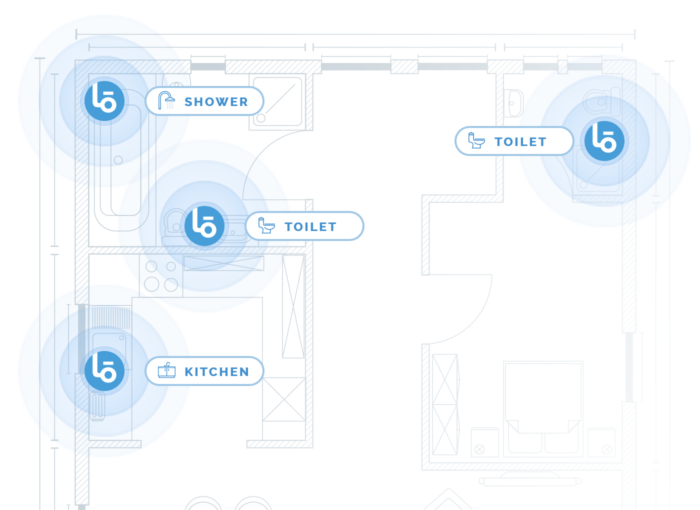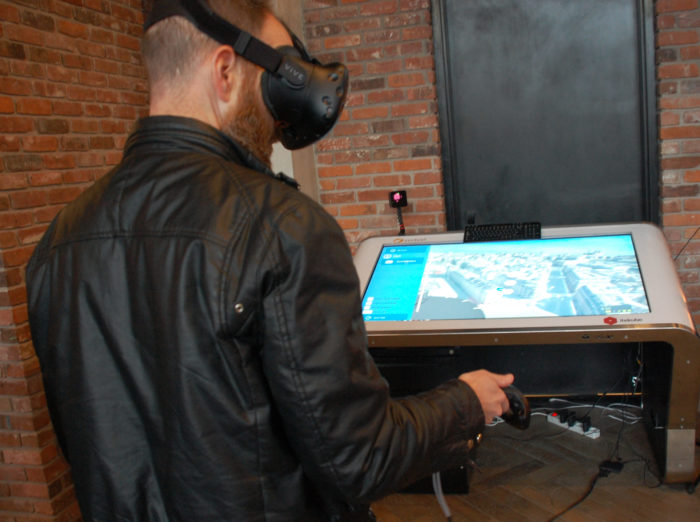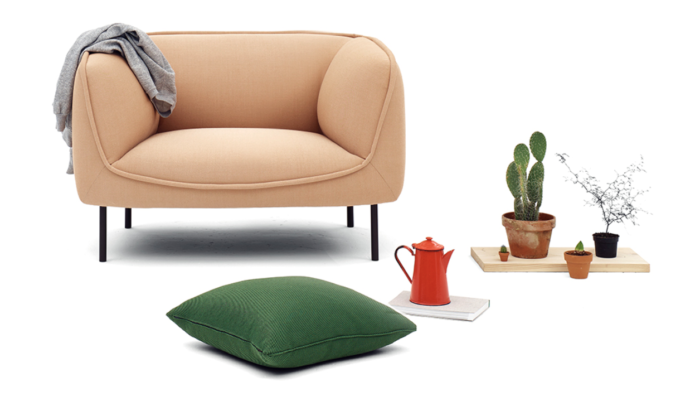5 Ways Tech Will Change Your Home and Office
At a Brooklyn demo, entrepreneurs touted smart ways to make our real estate more liveable
A pilot project of Waltz access technology (Photo courtesy of Waltz)
Imagine having sensors that could detect water leaks in your building. Or using your smartphone as a key to your office. Or shopping for an apartment by checking out prospects with a virtual-reality headset. All of these are examples of how technology is coming to real estate. You’ve probably already heard of “EdTech” (for schools) and “FinTech” (for finance). Now comes “ReTech,” which promises to make buildings smarter, safer, thriftier, and even more smartly furnished.
Five entrepreneurs in the field pitched their new offerings this week at the Williamsburg Hotel, the first of a series of quarterly ReTech demos hosted by the real-estate development firm Totem and a rotating cast of partners. Tucker Reed, a principal in Totem, suggested that tech could bring the biggest changes since the installation of the first public elevator by Elisha Otis in 1874. Smart buildings, he said, will be part of “the everyday application of technological overlays and innovative services that are about to become integrated into every aspect of our lives.”
For landlords and developers, the three big reasons to invest in tech are to save money on energy and maintenance, to boost productivity, and to increase tenant satisfaction, said Ryan Baxter, a vice president at the Real Estate Board of New York. While real estate represents a huge portion of all assets, Baxter noted, investment in tech to improve real-estate assets has been relatively tiny compared with other tech. “It’s finally ReTech’s turn,” he said.
The cost of ReTech has fallen enough that it’s not just for big buildings; smaller operators can afford upgrades that can make a difference to customers. But building owners need to be discriminating in how they dive into new tech since it develops so quickly, Peter Lawrence, principal owner of Williamsburg’s Wythe Hotel, told The Bridge. “The tech has to line up with the rest of the things you’re doing, the story you’re telling.” (At the Wythe, that means radiant heated floors in all the guest rooms.) Above all, the tech has to be highly customer-friendly. “Technology in your home is very different from the technology in your hotel,” said Lawrence. “If it doesn’t work in four seconds, it’s a problem.”
1. Think of Siri, but with legs

Hello Alfred CEO Marcela Sapone (Photo by Noam Galai/Getty Images for TechCrunch)
“We focus on the simple things that take up a lot of time,” said Marcela Sapone, co-founder and CEO of Hello Alfred, a household task-performing service. When you sign up with an app, the firm assigns a hand-picked “Alfred” who will do your grocery shopping, ship your packages, find a dog walker, and generally help you manage your home. The assistant visits on a regular schedule and uses a database to keep track of your preferences, for example not just that you need to buy eggs, but you want the organic, free-range kind. Sapone stressed the trust factor: the company has “six layers of vetting” for the Alfreds, who are full-fledged W-2 employees rather than freelancers. A story in this week’s New Yorker on the “gig economy” recounts how Tom Perez, the new chairman of the Democratic National Committee, dropped by the Hello Alfred offices to meet Sapone because he considers the company “to be a model–creative, well-intentioned, and kind toward its employees…”
As a new business, Hello Alfred is scaling up by working with owners of large residential buildings who want to offer the service as an amenity. And where did the name come from? Alfred, you may recall, is the butler to Batman, “the only superhero who’s a normal man,” notes Sapone.
2. Managing water as a precious commodity

(Illustration courtesy of Lotik)
Did you know that one of every five toilets in New York City is leaking? And that tap water isn’t free? In fact, a 65-unit apartment building spends more than $60,000 a year on water, all told. That’s a business opportunity for a tech startup called Lōtik Labs, which offers water monitoring as a service. “We listen to the pipes,” said Shane Eten, Lōtik’s CEO. How that works: Lōtik clamps specially developed sensors onto water pipes near the point of use, where they can detect water flow by picking up vibrations. The sensors are discreet and tamper-proof. A wireless gateway sends information for analysis by proprietary algorithms, and the results are displayed on a digital dashboard.
The data enables a building operator to detect problems as well as usage patterns. The difference with Lōtik, compared to conventional water meters, is that it can micro-monitor usage, fixture-by-fixture. In fact, the startup is in discussions with plumbing-fixture makers about building the sensors right into those products. So far, the venture has been financed by Samsung, and is in the process of a $6 million financing round.
3. A pass that does much more than open doors
While our MetroCards and corporate ID cards still seem fairly modern, they’re actually pretty dumb and one-dimensional. Waltz is a startup that uses mobile devices as a means to pay for mass transit and enter buildings. But it’s not just a key, it’s more of an information portal. Transit operators can communicate with riders. Building owners can communicate with tenants about events and emergencies. The Waltz system can even be a moneymaker for landlords as “a platform to market to the captive audience,” said Matt Kopel, the startup’s CEO. Waltz produces several links in the access chain: the app on the phone, the hardware and software on the turnstiles or doors, and the back-end management of all the information that’s produced.
The interface between user and facility is notably secure, Kopel said, since it involves an exchange of constantly changing visual images. Waltz has a pilot program at the Brookfield Place complex in lower Manhattan and is in the midst of a $5 million round of series A funding, Kopel said.
4. A virtual visit to your future home or office

Trying out the 3D renderings produced by Vectuel (Photo by Steve Koepp)
Vectuel US is a firm on the front edge of how buildings are now planned, approved, built and sold. What used to be done with blueprints and scale models is increasingly digital, in 3D renderings. Even from the beginnings of a project, the planners can visualize how a structure would occupy its neighborhood by making a 3D map of the built environment, typically by flying an aircraft over it with sensors, said Claire Flurin, Vectuel US director of urban planning. A proposed building and its surroundings can be toured from many vantage points by using VR headsets, even by multiple users in discussion. As a project moves forward, the digital model can be used for government approvals and later as a marketing tool. “We can build a beautiful tour,” said Flurin. The cost of a 3D model starts at about $15,000 to $20,000, according to the Vectuel US team.
5. Cool furniture without the burdens

ZZ Driggs offers furniture by subscription (Illustration courtesy of ZZ Driggs)
The old model of furnishing your home was to buy the best you could afford, make it last, and maybe pass it to your children. The proposition of startup ZZ Driggs is that you can get smartly designed, locally sourced furnishings without a long-term commitment. But don’t call it renting, because that would be declasse. Call it furniture on subscription, “for when you want, for as long as you want,” said Whitney Falk, founder and CEO. Prices begin at $50 a month per item; an average piece is $125 per month. Customers can choose pieces a la carte or in collections, with a complimentary design consultant to help bring the room together.
Falk mentioned in her presentation that she’s from Michigan, home of the forward-thinking Herman Miller furniture maker, and that modern sensibility is reflected in ZZ Driggs’ designs. Asked about the association of rental furniture with companies that charge high prices to low-income customers, Falk said the idea of “collaborative consumption” has become much more acceptable with the arrival of brands like Zipcar and Airbnb. Sounds like a good way for a binge watcher to order up a stylish new sofa.
Editor’s note: Tucker Reed, a host of the ReTech demo, is a contributing writer to The Bridge.













